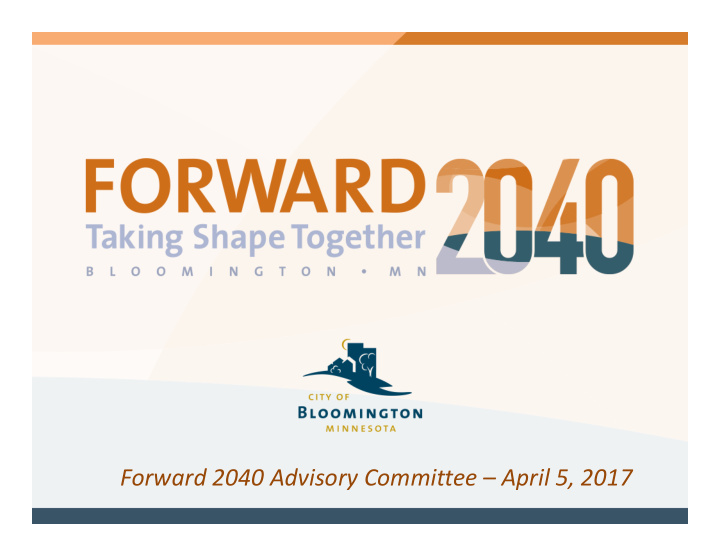



Forward 2040 Advisory Committee – April 5, 2017
Agenda 1. Draft Vision and Value Statements Update (5 minutes) ‐ Julie 2. Transportation Element ‐ Overview (60 ‐ 70 minutes) ‐ Jason 3. Airport Element ‐ Overview (30 ‐ 40 minutes) ‐ Mike
Vision & Values
Transportation Element ‐ Overview • Review 2008 Transportation Element & Met Council minimum requirements • Discuss Opportunities, and Challenges facing Transportation in the next 20 years • Next Steps
Met Council Requirements Transportation Analysis Zones Allocate forecasted pop, household, and employment growth by TAZ Roadways Describe and map the functional classification of existing/proposed roads Transit Describe and map the existing and planned transit infrastructure services Describe roles and responsibilities in transitway development / station area planning Bicycling and Walking Describe and map existing and planned on ‐ road bicycle facilities Analyze and address bicycle/pedestrian facility improvements Freight Identify railways, barge facilities and freight terminals Identify roadway issues or problem areas for good movements
Transportation Work Group – Items Identified • Impacts of Transportation Technology • Aging Infrastructure • Mobility vs. Accessibility • Roadway System • Bikeways / Walkway System • Transit System
Impacts of Transportation Technology • Coordinating traffic lights – Reduce congestion – Improve traffic flow – Reduce exhaust • Autonomous vehicles – Lane width – Congestion (unclear) – Pavement markings – Narrow lane widths – Charging stations – Transit • Drone delivery – ADA compliance • Cut ‐ through traffic
Aging Infrastructure • Pavement Management – Streets and trails – Prolong pavement life • Franchise fee ‐ trails – Covers replacement of existing trails (not new trails) – Trails in parks (maintenance)
Mobility vs. Accessibility • Move traffic to provide high traffic flow – Reduce exhaust concentration • Keep streets narrow – Pedestrian friendly – Congestion increases – Cut ‐ through traffic • One size does not fit all – Normandale Lake – South Loop – Penn American • Travel Demand Management
Roadway System • Safety – Engineering – Enforcement – Education • Functional Roadway Classification – Mobility and land access – Reroutes / shortcuts • Traffic calming
Functional Roadway Classification, 2008
Bikeways / Walkway System • Alternative Transportation Plan and Safe Routes to School – Promotes transportation system for cyclists and pedestrians – Addresses barriers – Missing gaps – Recommended priorities
ATP System
Existing System & Gaps
ATP System Hierarchy
ATP System – Priority Regional Trail connections highlighted
Local Connections – Priority Example W 102 nd Street Bikeway
Criteria for Prioritizing • Community Demand • Redevelopment / Upgrading of Alternative Transportation Facility • Redevelopment Opportunity • Funding Availability / Partnership Opportunity • Safety • Accessibility • Economic Efficiency
Continued ‐ Bikeways / Walkway System • Temporary Infrastructure – For testing • Education, Marketing and Promotion – Promote short trips – Leverage partnership with Bicycle Alliance – Open streets, bicycle rodeos – Maps and signs – Website / social media
Transit System • Transit deficiencies – Suburb to suburb connection – Improve efficiency of inter ‐ city transit • Specific user groups dependent on transit • Land Use – Transit Relationships
Next Steps • Prepare draft plans – Draft goals, strategies and priorities for each plan • Present to the advisory committee in late summer
Airport Element ‐ Overview • Review 2008 Airport Element & Met Council minimum requirements • Discuss Opportunities, and Challenges facing Airports in the next 20 years • Next Steps
Requirements Map – Boundaries – Land use – Zoning Explain how City Implements Airport Zoning Requirements
2008 Airport Element • Safety • Noise – Land Uses – Mitigation Programs – Height Restrictions • Effect on Airport South District (South Loop) – Zoning
Zoning/Land Use • MnDOT – Go beyond FAA – Exception for existing urban airports – Potential changes in 2017 • Metropolitan Airport Commission (MAC) Zoning Regulations – Balance between Safety and Economic Development
Airport Safety Zone
Expanding Airport Operations
Airport Planning ‐ Investment https://reimaginemsp.com/gates/
https://Reimaginemsp.com/parking ‐ ground ‐ transportation ‐ and ‐ roadways/
Airport Planning ‐ Investment • Expansion of Humphrey Terminal – Interchange at I ‐ 494 and 34 th Street was reconstructed • New Parking Facilities – Potential to repurpose areas dedicated to airport parking
Diverging Diamond Interchange Park N’ Go Park ’N Go Park ’N Fly
Expanding Airport Operations • Tourism – Effect on hotel industry – Mall of America and other Attractions – Attractive to Corporations http://wanderthemap.com/2015/12/snorkeling ‐ at ‐ the ‐ mall ‐ of ‐ america/
Noise
Noise • FAA incompatible land uses • Met Council incompatible land uses
Recommend
More recommend